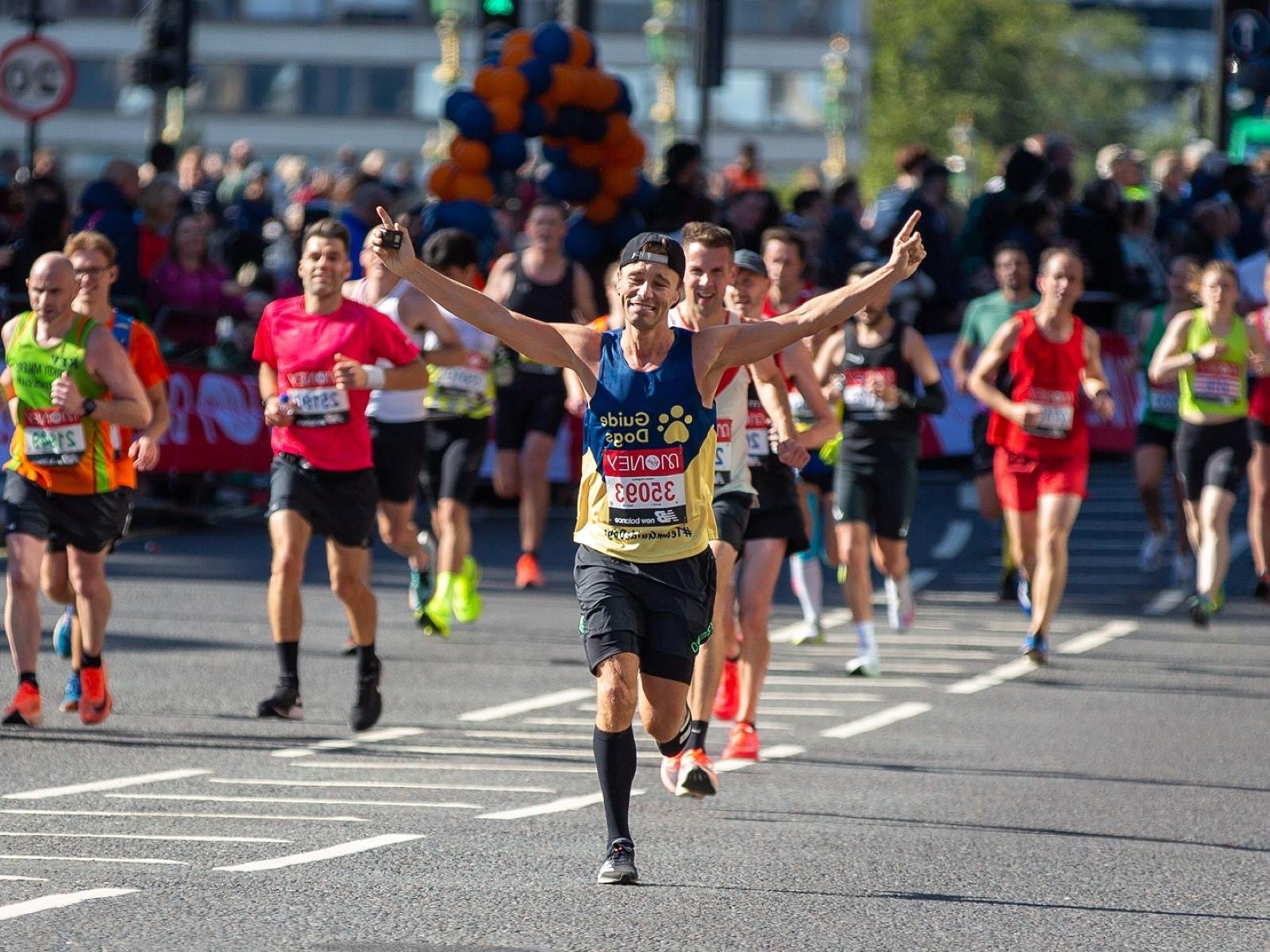Home>Training & Techniques>Mastering The Art Of Pacing For A Flawless Marathon


Training & Techniques
Mastering The Art Of Pacing For A Flawless Marathon
Published: March 5, 2024
Learn the best training & techniques for mastering marathon pacing. Achieve a flawless performance with expert tips and strategies. Start your journey to success today!
(Many of the links in this article redirect to a specific reviewed product. Your purchase of these products through affiliate links helps to generate commission for Therunningadvisor.com, at no extra cost. Learn more)
Table of Contents
Understanding the Importance of Pacing
Pacing is the cornerstone of a successful marathon performance. It involves maintaining a consistent speed throughout the race, ensuring that energy reserves are optimally utilized. Understanding the importance of pacing is crucial for every marathon runner, as it directly impacts performance and overall experience.
Pacing plays a pivotal role in preventing early burnout. Starting too fast can lead to premature exhaustion, diminishing the ability to maintain momentum in the later stages of the race. Conversely, starting too slow may result in the inability to make up for lost time, leading to dissatisfaction with the overall performance.
Effective pacing also contributes to efficient energy management. By maintaining a steady pace, runners can conserve energy for the latter part of the race, where endurance and mental fortitude are paramount. This approach minimizes the risk of hitting the proverbial "wall," a state of physical and mental depletion that can derail even the most seasoned runners.
Furthermore, pacing impacts the psychological aspect of the race. Consistent pacing instills confidence and a sense of control, promoting a positive mindset that is essential for enduring the challenges of a marathon. It allows runners to stay focused, maintain motivation, and strategically plan their efforts, leading to a more enjoyable and fulfilling race experience.
In essence, understanding the importance of pacing is not just about achieving a specific finish time; it's about optimizing performance, preserving energy, and cultivating a resilient mindset. By embracing the significance of pacing, runners can approach the marathon with a well-defined strategy, setting the stage for a successful and gratifying race day.
Read more: Mastering The Art Of Running A Flawless 10K
Setting Realistic Pace Goals
Setting realistic pace goals is a fundamental aspect of marathon preparation. It involves a comprehensive assessment of individual capabilities, race conditions, and long-term objectives. By establishing achievable pace targets, runners can optimize their performance, minimize the risk of burnout, and enhance the overall race experience.
When setting pace goals, it's essential to consider personal fitness levels and training progress. This involves an honest evaluation of current running abilities, endurance, and speed. By acknowledging individual strengths and limitations, runners can establish realistic pace benchmarks that align with their physical capabilities. This approach fosters a sense of attainability, reducing the likelihood of setting unfeasible goals that may lead to frustration or disappointment during the race.
Additionally, factoring in external variables such as weather conditions, course terrain, and altitude is crucial when determining pace goals. Adverse weather, hilly terrains, or high altitudes can significantly impact running performance. Therefore, it's imperative to adjust pace expectations accordingly to accommodate these external factors, ensuring that goals remain attainable despite potential challenges.
Moreover, long-term objectives and race strategies should inform the establishment of pace goals. Whether aiming for a personal best, a qualifying time for another race, or simply aiming to finish strong, aligning pace targets with overarching aspirations is essential. This strategic approach enables runners to tailor their pace goals to reflect their desired outcomes, fostering a sense of purpose and direction throughout the race.
Furthermore, seeking insights from experienced coaches, fellow runners, or utilizing pacing calculators can provide valuable guidance in setting realistic pace goals. Leveraging external expertise and resources can offer a well-rounded perspective, helping runners make informed decisions and refine their pace targets based on expert insights and empirical data.
In essence, setting realistic pace goals is a multifaceted process that integrates self-assessment, environmental considerations, strategic alignment, and external input. By approaching pace goal setting with a comprehensive and informed mindset, runners can establish targets that are both challenging and achievable, laying the groundwork for a successful and fulfilling marathon performance.
Strategies for Maintaining Consistent Pace
Maintaining a consistent pace throughout a marathon is a formidable challenge that demands a strategic approach and unwavering discipline. Implementing effective strategies for sustaining a steady speed is essential for optimizing performance and achieving race day success.
One of the primary strategies for maintaining a consistent pace is to start the race at an even, controlled speed. This approach allows runners to establish a comfortable rhythm without expending excessive energy in the initial stages. By resisting the temptation to sprint at the onset, runners can conserve valuable physical and mental resources, setting the stage for a sustainable and enduring performance.
Another vital strategy involves leveraging pacing tools and technology. Utilizing GPS watches, pace bands, or mobile applications can provide real-time feedback on current speed and overall progress. These tools enable runners to monitor their pace, make necessary adjustments, and stay within their target speed range. By staying attuned to their pace, runners can proactively manage their efforts, mitigating the risk of erratic speed fluctuations.
Furthermore, practicing effective breathing techniques and maintaining a relaxed posture are integral components of sustaining a consistent pace. Controlled breathing patterns and a relaxed physical demeanor contribute to efficient energy utilization and overall endurance. By prioritizing proper breathing and posture, runners can optimize oxygen intake, minimize muscle tension, and sustain a steady pace throughout the race.
Additionally, breaking the race into manageable segments and focusing on incremental milestones can aid in maintaining a consistent pace. By mentally dividing the marathon into smaller, achievable sections, runners can stay motivated and engaged, preventing mental fatigue and performance fluctuations. This approach fosters a sense of control and progress, bolstering the ability to sustain a steady speed from start to finish.
Moreover, adhering to a well-structured training regimen that incorporates pace-specific workouts is instrumental in honing the ability to maintain consistent speed. Interval training, tempo runs, and race-pace simulations are valuable training components that acclimate runners to sustaining a targeted speed over extended distances. By integrating these workouts into their training routine, runners can develop the physical and mental resilience necessary for maintaining a consistent pace on race day.
In essence, implementing strategies for maintaining a consistent pace is a multifaceted endeavor that encompasses prudent race initiation, technological support, physiological considerations, mental fortitude, and targeted training. By embracing these strategies, runners can cultivate the resilience and discipline needed to uphold a steady speed, ultimately enhancing their marathon performance and achieving their pacing objectives.
Mental Techniques for Managing Pacing
Mental fortitude plays a pivotal role in managing pacing during a marathon. The ability to harness the mind's resilience and focus is instrumental in maintaining a steady speed throughout the race. Implementing specific mental techniques can empower runners to effectively manage their pacing, optimize performance, and navigate the inevitable challenges of a marathon.
One of the fundamental mental techniques for managing pacing is visualization. By mentally rehearsing the race scenario, including maintaining a consistent pace, runners can cultivate a sense of familiarity and preparedness. Visualizing themselves running at their desired speed, overcoming obstacles, and staying composed amid fatigue can instill confidence and a proactive mindset. This mental imagery primes the brain to adapt to the anticipated demands of pacing, fostering a sense of control and readiness.
Furthermore, adopting a positive self-talk approach is paramount in managing pacing effectively. Internal dialogue that reinforces determination, resilience, and adaptability can bolster mental strength during the race. Encouraging mantras, affirmations, and self-motivating statements can counteract negative thoughts and doubts, empowering runners to stay focused on their pacing goals. By cultivating a positive internal narrative, runners can sustain their resolve and composure, mitigating the impact of mental fatigue on pacing consistency.
Moreover, practicing mindfulness and staying present in the moment is a valuable mental technique for managing pacing. By directing attention to the current stride, breathing rhythm, and overall physical sensations, runners can anchor themselves in the present, minimizing distractions and anxiety about future segments of the race. This mindfulness fosters a heightened awareness of pacing dynamics, enabling runners to make real-time adjustments and maintain a steady speed with greater precision.
Additionally, embracing adaptability and resilience as core mental attributes is essential for managing pacing challenges. Acknowledging that unforeseen circumstances, such as unexpected fatigue or environmental factors, may arise during the race allows runners to adopt a flexible mindset. Embracing adaptability empowers runners to recalibrate their pacing strategy as needed, ensuring that they can navigate fluctuations in energy levels and external conditions without compromising overall performance.
In essence, leveraging mental techniques for managing pacing is a dynamic and integral aspect of marathon preparation and execution. By integrating visualization, positive self-talk, mindfulness, and adaptability into their mental toolkit, runners can fortify their psychological resilience, optimize pacing management, and elevate their overall marathon experience. These mental techniques serve as invaluable assets, empowering runners to navigate the complexities of pacing with confidence, composure, and unwavering determination.
Training Tips for Improving Pacing
Training plays a pivotal role in enhancing pacing proficiency for marathon runners. By incorporating specific strategies and workouts into their training regimen, runners can refine their ability to maintain a consistent speed, optimize energy utilization, and bolster overall race performance.
One fundamental training tip for improving pacing is to integrate tempo runs into the training schedule. Tempo runs involve sustaining a challenging, yet manageable pace for an extended duration, simulating the demands of race-day pacing. By incorporating regular tempo runs into their training routine, runners can acclimate their bodies and minds to maintaining a targeted speed over prolonged distances, fostering the physical and mental resilience necessary for effective pacing.
In addition to tempo runs, interval training is a valuable component for refining pacing capabilities. Interval workouts involve alternating between high-intensity bursts of speed and periods of active recovery. This training approach not only enhances overall speed and endurance but also cultivates the ability to modulate pace efficiently. By honing the capacity to transition between different speed levels, runners can develop a nuanced understanding of pacing dynamics, enabling them to make strategic adjustments during the race.
Furthermore, practicing race-pace simulations during training is instrumental in improving pacing acumen. By dedicating specific training sessions to mirror the anticipated race pace, runners can familiarize themselves with the physical and mental demands of sustaining a targeted speed. This approach allows for practical experimentation with pacing strategies, enabling runners to identify optimal techniques for maintaining consistency and managing energy reserves effectively.
Another valuable training tip for improving pacing is to prioritize long runs with negative splits. Negative splits involve running the second half of a long-distance run at a faster pace than the first half. By incorporating negative split long runs into their training routine, runners can cultivate the ability to execute controlled pacing, conserve energy for the latter stages of the race, and finish strong. This training approach instills confidence in pacing capabilities and reinforces the importance of strategic energy distribution.
Moreover, leveraging pacing feedback from training runs, such as utilizing GPS watches or mobile applications, provides valuable insights into individual pacing patterns and areas for improvement. Analyzing training data allows runners to identify pacing inconsistencies, refine their speed management strategies, and make informed adjustments to optimize pacing efficiency.
In essence, integrating tempo runs, interval training, race-pace simulations, negative split long runs, and leveraging pacing feedback from training runs are essential training tips for improving pacing. By incorporating these strategies into their training regimen, runners can elevate their pacing proficiency, fortify their endurance, and cultivate the strategic acumen necessary for a successful marathon performance.
Read more: Mastering The Art Of Early Morning Running
Adjusting Pace During the Race
Adaptability and strategic decision-making are essential components of successful marathon performance, and the ability to adjust pace during the race is a skill that can significantly impact overall outcomes. As runners progress through the marathon, various factors, including terrain changes, weather conditions, and individual energy levels, may necessitate modifications to their pace. Effectively navigating these adjustments requires a combination of situational awareness, mental agility, and a keen understanding of pacing dynamics.
One of the primary considerations when adjusting pace during the race is the evaluation of environmental and terrain factors. As runners encounter uphill or downhill segments, it is crucial to recalibrate their pace to accommodate these variations. Uphill sections may warrant a reduction in speed to conserve energy, while downhill stretches may allow for a controlled acceleration without overexertion. By adapting pace to the terrain, runners can optimize energy expenditure and maintain a sustainable rhythm throughout the race.
Furthermore, monitoring internal cues and physical sensations is integral to making informed pace adjustments. Sensations of fatigue, dehydration, or muscular discomfort may signal the need to moderate pace to prevent premature exhaustion. Conversely, feeling strong and resilient may present opportunities to cautiously increase speed without compromising overall endurance. By staying attuned to their bodies, runners can make real-time pace adjustments that align with their physical capabilities and energy reserves.
In addition to internal cues, leveraging external feedback, such as split times and mile markers, provides valuable insights for adjusting pace during the race. Comparing current pace with pre-established targets and evaluating intermediate milestones allows runners to gauge their progress and make calculated adjustments as needed. This data-driven approach empowers runners to maintain pacing consistency and adapt to evolving race conditions with precision.
Moreover, mental resilience and adaptability play a pivotal role in executing effective pace adjustments. Embracing a flexible mindset and remaining open to recalibrating pace in response to unforeseen circumstances fosters a proactive and resilient approach to pacing management. By acknowledging that pacing adjustments are a natural and strategic aspect of marathon running, runners can navigate these transitions with composure and confidence.
In essence, adjusting pace during the race is a dynamic and strategic process that demands attentiveness, adaptability, and mental fortitude. By integrating environmental considerations, internal cues, external feedback, and a resilient mindset, runners can make informed and effective pace adjustments, optimizing their performance and enhancing their overall marathon experience. This adaptive approach to pacing empowers runners to navigate the complexities of the race with agility and strategic acumen, ultimately contributing to a successful and fulfilling marathon performance.
Recovering from Pacing Setbacks
Recovering from pacing setbacks during a marathon is a formidable challenge that demands resilience, adaptability, and strategic acumen. Despite meticulous preparation and disciplined pacing strategies, unforeseen obstacles such as fatigue, unexpected weather changes, or fluctuating energy levels can disrupt the intended pacing plan. Effectively rebounding from these setbacks is essential for regaining momentum, preserving mental fortitude, and optimizing overall race performance.
One of the primary approaches to recovering from pacing setbacks is to embrace a proactive mindset. Acknowledging the setback as a temporary deviation from the pacing plan rather than a definitive obstacle is crucial. By reframing the setback as an opportunity to recalibrate pacing strategies and demonstrate adaptability, runners can mitigate the psychological impact of the setback and refocus their energy on the remaining race ahead.
Moreover, leveraging mental resilience techniques, such as positive self-talk and visualization, can aid in recovering from pacing setbacks. Encouraging internal dialogue that reinforces determination, perseverance, and adaptability can counteract feelings of frustration or disappointment. Visualizing a smooth and controlled pacing rhythm, even after a setback, can instill confidence and a sense of renewed purpose, empowering runners to navigate the remainder of the race with composure and resolve.
Additionally, implementing gradual pacing adjustments following a setback is instrumental in regaining pacing consistency. Rather than attempting to immediately revert to the original pace, incrementally increasing speed in a controlled manner allows for a smoother transition and minimizes the risk of overexertion. This gradual approach enables runners to regain their pacing rhythm while conserving energy for the latter stages of the race, ultimately contributing to a more sustainable and resilient performance.
Furthermore, seeking external support and encouragement from fellow runners, spectators, or race volunteers can provide a valuable morale boost during the recovery from pacing setbacks. The collective energy and encouragement from the race environment can reignite motivation and determination, fostering a renewed sense of purpose and resilience in the face of pacing challenges.
In essence, recovering from pacing setbacks is a dynamic and multifaceted process that encompasses mental fortitude, adaptability, and strategic pacing adjustments. By embracing a proactive mindset, leveraging mental resilience techniques, implementing gradual pacing adjustments, and seeking external support, runners can effectively rebound from setbacks, regain pacing consistency, and navigate the complexities of the marathon with renewed determination and resilience. This adaptive approach to recovering from pacing setbacks empowers runners to optimize their performance and cultivate a gratifying marathon experience.
Fine-Tuning Your Pacing for Race Day
Fine-tuning pacing for race day is a meticulous process that encompasses strategic preparation, mental readiness, and a comprehensive understanding of individual capabilities. As the culmination of training and anticipation, race day presents an opportunity for runners to apply refined pacing strategies and execute a well-crafted plan with precision and determination.
One of the foundational elements of fine-tuning pacing for race day is to conduct a thorough review of training data and performance metrics. Analyzing previous race performances, training runs, and pacing patterns provides valuable insights into individual strengths, areas for improvement, and pacing tendencies. By identifying patterns and trends in pacing behavior, runners can tailor their race day pacing strategy to align with their demonstrated capabilities, optimizing their chances for a successful performance.
Furthermore, establishing a detailed race day pacing plan that integrates specific mile-by-mile or kilometer-by-kilometer targets is essential for fine-tuning pacing. By breaking down the race distance into manageable segments and setting precise pacing benchmarks for each stage, runners can maintain a structured and disciplined approach throughout the race. This granular pacing plan serves as a strategic roadmap, guiding runners to navigate the complexities of the marathon with clarity and purpose.
In addition to meticulous planning, mental readiness plays a pivotal role in fine-tuning pacing for race day. Cultivating a resilient and focused mindset, visualizing successful pacing execution, and reinforcing positive self-talk are integral components of mental preparation. By embracing a confident and determined outlook, runners can fortify their mental fortitude, mitigate pre-race jitters, and approach the starting line with a sense of purpose and readiness to execute their pacing plan.
Moreover, leveraging pacing feedback from pre-race warm-up runs or shorter distance races can offer valuable real-time insights into pacing dynamics and physical readiness. Utilizing these opportunities to fine-tune pacing strategies, make minor adjustments, and gauge energy levels can inform last-minute pacing refinements, ensuring that runners are primed to execute their pacing plan with precision and confidence.
In essence, fine-tuning pacing for race day is a comprehensive and strategic endeavor that integrates data analysis, meticulous planning, mental readiness, and real-time adjustments. By embracing a holistic approach to pacing refinement, runners can optimize their performance, navigate the intricacies of the marathon with confidence, and ultimately achieve their pacing objectives with precision and determination.















